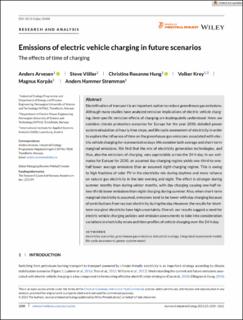| dc.contributor.author | Arvesen, Anders | |
| dc.contributor.author | Völler, Steve | |
| dc.contributor.author | Hung, Christine Roxanne | |
| dc.contributor.author | Krey, Volker | |
| dc.contributor.author | Korpås, Magnus | |
| dc.contributor.author | Strømman, Anders Hammer | |
| dc.date.accessioned | 2021-11-04T12:41:10Z | |
| dc.date.available | 2021-11-04T12:41:10Z | |
| dc.date.created | 2021-06-09T13:38:19Z | |
| dc.date.issued | 2021 | |
| dc.identifier.citation | Journal of Industrial Ecology. 2021, 25 (5), 1250-1263. | en_US |
| dc.identifier.issn | 1088-1980 | |
| dc.identifier.uri | https://hdl.handle.net/11250/2827897 | |
| dc.description.abstract | Electrification of transport is an important option to reduce greenhouse gas emissions. Although many studies have analyzed emission implications of electric vehicle charging, time-specific emission effects of charging are inadequately understood. Here, we combine climate protection scenarios for Europe for the year 2050, detailed power system simulation at hourly time steps, and life cycle assessment of electricity in order to explore the influence of time on the greenhouse gas emissions associated with electric vehicle charging for representative days. We consider both average and short-term marginal emissions. We find that the mix of electricity generation technologies, and thus, also the emissions of charging, vary appreciably across the 24-h day. In our estimates for Europe for 2050, an assumed day-charging regime yields one-third-to-one-half lower average emissions than an assumed night-charging regime. This is owing to high fractions of solar PV in the electricity mix during daytime and more reliance on natural gas electricity in the late evening and night. The effect is stronger during summer months than during winter months, with day charging causing one-half-to-two-thirds lower emissions than night charging during summer. Also, when short-term marginal electricity is assumed, emissions tend to be lower with day charging because of contributions from nuclear electricity during the day. However, the results for short-term marginal electricity have high uncertainty. Overall, our results suggest a need for electric vehicle charging policies and emission assessments to take into consideration variations in electricity mixes and time profiles of vehicle charging over the 24-h day. | en_US |
| dc.language.iso | eng | en_US |
| dc.publisher | Wiley | en_US |
| dc.rights | Navngivelse-Ikkekommersiell 4.0 Internasjonal | * |
| dc.rights.uri | http://creativecommons.org/licenses/by-nc/4.0/deed.no | * |
| dc.title | Emissions of electric vehicle charging in future scenarios: The effects of time of charging | en_US |
| dc.type | Peer reviewed | en_US |
| dc.type | Journal article | en_US |
| dc.description.version | publishedVersion | en_US |
| dc.source.pagenumber | 1250-1263 | en_US |
| dc.source.volume | 25 | en_US |
| dc.source.journal | Journal of Industrial Ecology | en_US |
| dc.source.issue | 5 | en_US |
| dc.identifier.doi | 10.1111/jiec.13144 | |
| dc.identifier.cristin | 1914833 | |
| dc.relation.project | Norges forskningsråd: 255199 | en_US |
| cristin.ispublished | true | |
| cristin.fulltext | original | |
| cristin.qualitycode | 2 | |

